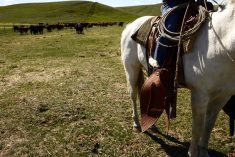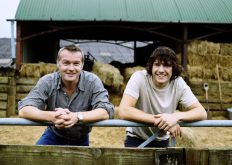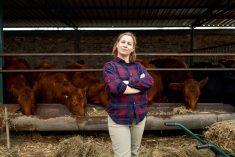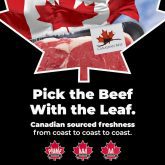The two largest variable costs facing the cattle-feeding sector are the calf and the feed needed to finish it. This makes the feed: gain ratio a key measure of efficiency. This column features a few research projects that illustrate how feedlot feed: gain (and growth rate, days on feed and carcass weight) have improved over the years.
In 1957, Frank Whiting of AAFC s Lethbridge Research Station decided to increase the amount of grain fed to Hereford and Angus steers (Can. J. Anim. Sci. 37: 50-57).Steers that were fed one-third concentrate and two-thirds forage needed 9.5 lbs. of feed for every pound of gain. Steers fed two-thirds concentrate and one-third forage ratio needed 7.8 lbs. of feed per pound of gain. This was an 18 per cent improvement in feed efficiency. Steers fed the higher-grain diet also grew faster (1.97 versus 1.58 lbs./day), finished sooner (206 versus 254 days), and produced heavier (516 versus 494 lbs.) and fatter carcasses (14 versus 12 mm grade fat). A few years later, Dr. Bob Hironaka and others at the Lethbridge Research Station showed that the feed: gain ratio of Hereford steers decreased (improved) by approximately 0.05 for each percentage increase in the level of concentrate fed (Can. J. Anim. Sci. 74: 495-501).
Read Also

A strategic approach to risk on the ranch
Given the increase in the value of livestock and the market volatility, we need to cover our risks. First,…
In the early 1980s, Dr. Roger Cohen and J.A. Cooper at the University of British Columbia compared growth performance in Hereford steers fed an 85 per cent concentrate diet, with or without an ionophore and growth implant (Can. J. Anim. Sci. 63:361-365).The control steers with no growth promotants had a feed: gain ratio of 8.1, and steers given both growth promotants had a feed: gain ratio of 6.4:1 (a 21 per cent improvement). Average daily gain for the control steers (2.60 lbs./day) was also lower than for the steers given both ionophore and an implant (3.13 lbs./day). These steers finished in just over 100 days, and produced carcasses that averaged 620 lbs. with six mm of fat.
In 2001, Hushton Block and others at the University of Saskatchewan published a pair of studies that compared growth performance and carcass quality in a variety of breed types, backgrounding periods, and slaughter endpoints in steers finished on an 87 per cent concentrate diet. The feed: gain ratio for the Hereford steers during the finishing period ranged from 5.6:1 to 5.9:1, growth rates averaged over 4.0 lbs./day, and carcasses exceeded 700 lbs. with 8.0 mm of fat (J. Anim. Sci. 79: 133-140 and 267-275).
These four studies all used Hereford steers, so some of the improvement in growth and efficiency may also be from genetic selection. In 2004, Flavio Schenkel and others at the University of Guelph reported that feed: gain ratio had a heritability of 0.37, which means that 37 per cent of an animal s feed: gain efficiency is due to genetics. A value of 0.37 is considered to be moderately heritable, which means that feed: gain will improve if you select for it. Of course, selecting breeding stock for improved feed efficiency means measuring how much feed each individual animal consumes. This is very difficult and expensive. However, feed: gain is genetically correlated with average daily gain, which means that some of the genes involved in growth rate are also involved in feed: gain ratio. This stands to reason, since average daily gain is part of the feed: gain calculation. So selecting for average daily gain will also improve feed: gain ratio. Residual feed intake (RFI) is of interest to breeders who want to improve feed efficiency without increasing the size of their cattle. RFI tries to identify differences in feed intake that are caused by differences in the animal s metabolic idling rate by factoring out things like growth rate and fat thickness that affect feed intake. RFI and feed: gain ratio also have about half of the same genes in common, so selecting for improved RFI in breeding stock will also lead to improved feed: gain in feedlot progeny. The GrowSafe feed intake system developed in Canada has made it easier to measure feed intake in cattle, and has become a highly valued tool at a number of university, federal and private research feedlots.
Producer checkoff funds from Alberta Beef Producers, Ontario Cattlemen s Association and the Beef Cattle Research Council are supporting several projects that might reduce the number of animals that need to be tested for feed efficiency. At AAFC s Lacombe Research Station, Al Schaefer is testing whether infrared animal temperature measurements are related to feed effi-ciency. At the University of Guelph, Steve Miller and Yuri Montaholi are measuring infrared images and a variety of hormone and enzymes in hopes of identifying quick, cheap and reliable predictors of feed efficiency. Steve Miller is also looking for DNA markers for feed efficiency, in collaboration with the University of Alberta and researchers in Australia and the U.S.
Research often takes a long time to produce small improvements. But a quick look back shows how industry is still benefiting from this and other work done by Canadian researchers long ago, and will continue to benefit in the future.
ReynoldBergenisthesciencedirectorofBeefCattleResearchCouncil.
















